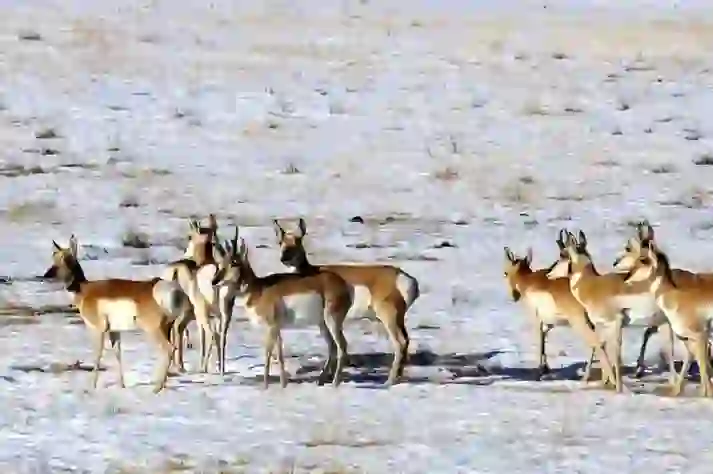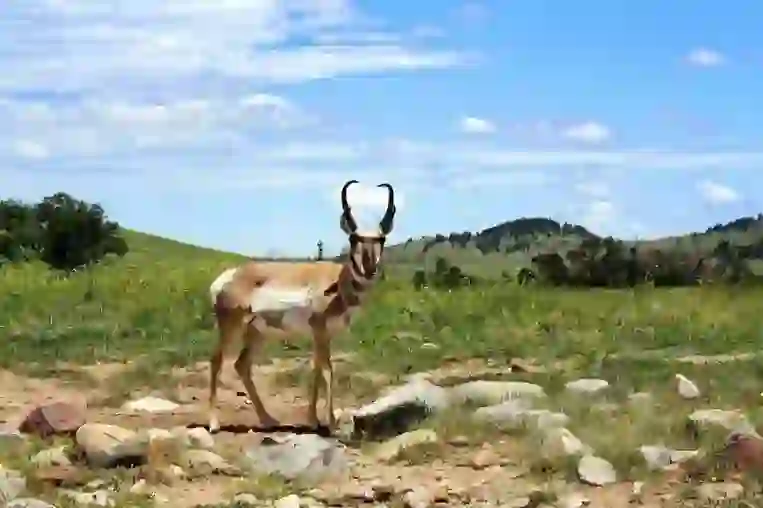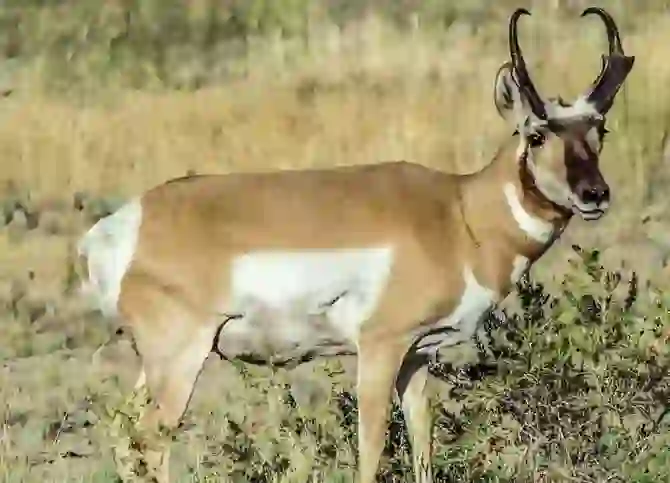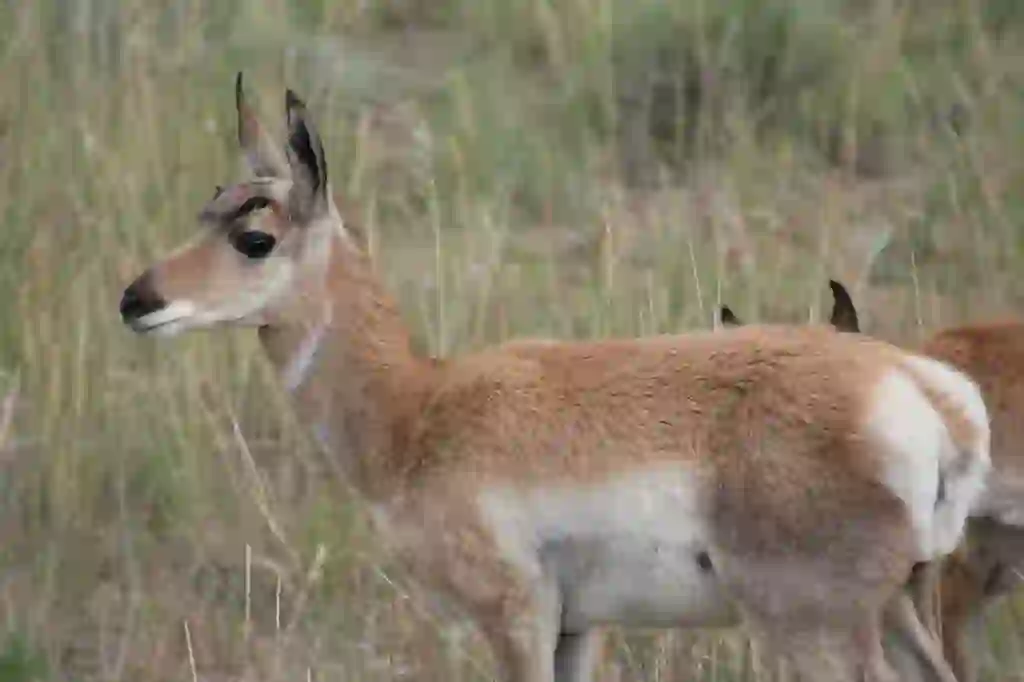
Pronghorn
Pronghorn
Pronghorn
Do you know the pronghorn, a herbivore that lives mainly in North America? Pronghorns are second fastest on land after cheetahs and can run as fast as 80km per hour. However, since they are bred only in a limited number of zoos, many people may have heard the name for the first time. Let's take a peek into its life together to find out what features and secrets pronghorns have in this article!
Pronghorn Basic Infomation

Mammalia-Cetartiodactyla-Antilocapraidae.
Length 100~150cm. Weight 40~70Kg.
Pronghorn is a herbivorous animal that inhabits North America and Mexico. It has a characteristic color of reddish-brown to yellowish-brown with white belly and buttocks, and white stripes around the throat.
They live in deserts and dry grasslands and form large herds of up to 1,000 individuals including males and females in winter, but live in small groups in spring.
Every autumn, male pronghorns form harems and mate within them. The gestation period is about 8 months and females give birth to 1-2 babies in the spring. Pronghorn babies stand up about 30 minutes after birth and can run faster than humans after a few days of life. After about a week of life, they can run faster than horses.
Pronghorn babies are vulnerable to predators, so mothers have a habit of hiding their babies in tall grass to raise them. To hide the presence of their babies from predators, mothers spend time away from their babies except when nursing every few hours. After about two weeks of life when the baby can run well, the mother returns to the herd with her baby.
Pronghorn Q&A

Where does pronghorn get its name?
The origin of the name “pronghorn” is said to come from its horns. “prong” means “pointed” and “horn” means “horn”. From this, it is thought that the name was given from the “pointed branched horns”.
The scientific name of pronghorn is expressed as “Antilocapra americana”, which means “American antelope goat”. However, pronghorns are not currently classified as antelopes and are thought to belong to the “pronghorn genus” that is classified only for pronghorns.

Why do pronghorns live there?
Pronghorns inhabit the western part of North America and the northern part of Mexico.
It seems that many animals similar to pronghorns once lived in North America and Mexico where pronghorns live. However, other animals have become extinct one after another due to changes in temperature and pressure from predators. Pronghorns are considered to be the only ones that have survived with their unique evolution.

What does pronghorn eat?
Pronghorns are herbivorous animals and live by eating all kinds of plants growing on grasslands.
Basically, they eat sagebrush and common sage growing on grasslands, but they also eat low shrubs and cacti. Pronghorns are basically resistant to dryness and can spend weeks without drinking water, relying only on the water obtained from food.
In zoos, they are given dried grass (hay) or herbivorous animal pellets as well as fresh plants and vegetables.

Is it true that pronghorns have unusual characteristics?
It's true.
Pronghorns are a very unusual herbivorous animal and are known for combining the characteristics of many herbivorous animals such as giraffes, goats, antelopes, and deer.
They look like deer or antelopes, but the animal that is closest to pronghorns among existing animals is considered to be giraffes.
The tips of pronghorns’ horns are pointed and hooked, and they have a unique feature that only the sheath part falls off every year and the base part remains. When we think about the horns of herbivorous animals that also ruminate, cows’ horns do not fall off, but deer’s horns fall off from the base every year.
In other words, the pronghorns’ horns that only fall off on the outside show an intermediate feature between cows and deer, and pronghorns are considered to be the only animals with such horns among many animals.
By the way, both males and females have horns, but female horns are considerably smaller than male horns and do not grow as large as branching or hooking.

Is it true that the pronghorn is the second fastest animal in the world?
It's true.
The maximum speed of pronghorns is about 80km per hour, making them the second fastest animal on land after cheetahs.
They are the fastest animal in North America and no other animal living in the same place can catch up with pronghorns. In addition, pronghorns have excellent endurance and can run long distances at about 40km per hour.
It is thought that the reason why pronghorns became fast runners was to escape from a cat-like animal called the “American cheetah” that lived during the Pleistocene epoch. The American cheetah became extinct around the end of the glacial period, but pronghorns seem to have survived with their speed.
By the way, pronghorns are also known for their excellent jumping ability. It is said that they can jump more than 6m horizontally in one jump.
However, they are not very good at jumping vertically, and many wild pronghorns cannot jump over enclosures that are about 1.2m high. Therefore, when they find obstacles with height (fences surrounding ranches or residential areas, etc.), they try to pass under them instead of jumping over them.

What kind of personality does pronghorn have?
Pronghorns are said to be very nervous because they have many opportunities to be targeted by predators. On the other hand, they are also very curious and have a side that approaches and investigates moving or unfamiliar things.
In the past, in the United States, when you tied a red handkerchief to a stick and waved it, a pronghorn came to you because curiosity prevailed over fear, so it was easy to catch it.

Can I keep a pronghorn as a pet?
When breeding rare animals at home, it is necessary to follow the established laws in some countries. This time, we will introduce whether it is possible to breed pronghorns at home in Japan.
Since the pronghorn is an artiodactyl animal, many inspections and conditions are considered to be required when imported from overseas. However, depending on the subspecies, it is probably not prohibited or restricted from keeping as a pet in terms of laws and treaties.
However, pronghorns have a very nervous personality, and it is difficult to raise adult individuals even in zoos where animal breeding professionals gather. On the other hand, since it becomes familiar to people when tamed from children, it seems that some people in the United States in the past kept pronghorns as pets.

Is there a place in Japan where I can see pronghorns?
Until September 2017, pronghorns were kept at the Kanazawa Zoo in Kanagawa Prefecture. However, unfortunately, there are no zoos in Japan that have kept pronghorns since then.
The last individual kept at the Kanazawa Zoo was a male named “Butch,” who lived well beyond the average lifespan and lived to be 15 years old. Butch was raised by artificial breeding and was said to be very friendly with people.

What is the lifespan of a pronghorn?
It is said that the lifespan of pronghorns in the wild is 7 to 10 years.
Because of their nervous nature, it is difficult to keep them in captivity, and they often cannot live out their lives in captivity.

What enemies does pronghorn have?
The natural enemies of pronghorns in the wild are carnivorous animals such as coyotes, bobcats, wolves, and eagles. In particular, coyotes are said to chase pronghorns around until they are exhausted and catch them.
But the biggest enemy of the nervous, cautious, and second-fastest running pronghorn in the world is not carnivores, but us humans.
Pronghorn once lived in North America with an estimated population of tens of millions (estimated at 35 million), but their grasslands were developed and they were over-hunted for food, reducing their numbers to about 10,000 at one point. Subsequently, hunting restrictions and habitat protection have helped to recover the pronghorn population, and it is now considered to be in little danger of extinction.
However, the subspecies "california pronghorn" once reduced its population to about 100 and was on the verge of extinction. Currently, a project is underway to protect the habitat and return it to the wild by breeding it in captivity. Since the pronghorn is still hunted in many areas and there are moves to develop its habitat, it seems that its future is not bright.
Note that pronghorns are classified as species that are affected or may be affected by trade as an endangered species under the Washington Convention only for populations living in Mexico and are listed in Appendix I.

Would you like to become a part of the 'Animalbook.jp'?
Turn your knowledge into Q&A and share it with the world. ※Publication will be activated after purchase. Let's share information together!
Pronghorn Type of List

- Pronghorn
Information
Congratulations! You are the first commenter!

Create Your Favorite List!
Pronghorn
Save the animals you love! Build your own list to quickly revisit your favorites later.

Would you like to leave a comment?
※Please note: This is for the purchase of rights to post comments within the article.
Find Your Favorites!
Our shop offers a unique and attractive selection of goods themed around various animals.
Pronghorn References

- E.T. シートン(著),今泉 吉晴(翻訳)(1998年)『シートン動物誌〈8〉シカの好奇心』E.T. シートン伊國屋書店
- 金沢動物園「金沢動物園のプロングホーン、スーチョワンバーラルが死亡しました」 http://www.hama-midorinokyokai.or.jp/zoo/kanazawa/author1709b/12aeaa7fcde43e6878f2c67ec4314a08d40db5d7.pdf
- ナショナルジオグラフィック「ナショナル ジオグラフィック日本版 2015年11月号 温暖化を味方にする動物は?」 https://natgeo.nikkeibp.co.jp/atcl/magazine/15/102300010/102400005/?img=ph7.jpg&P=2
- ナショナルジオグラフィック「動物大図鑑 プロングホーン」 https://natgeo.nikkeibp.co.jp/nng/article/20141218/428896/
- ナショナルジオグラフィック「マガジン/2010年11月号 シリーズ 地球と、生きる 動物たちの地球大移動」 https://natgeo.nikkeibp.co.jp/nng/magazine/1011/feature03/_03.shtml
- 一般財団法人 静岡市立動物園協会「ZOOしずおか 2021年90」 http://www.szga.jp/wp-content/uploads/2021/02/35a167fb6af8d72cf825b52ce0200e83.pdf
- San Diego Zoo Wildlife Alliance「Pronghorn (Antilocapra americana) Fact Sheet: Taxonomy & History」 https://ielc.libguides.com/sdzg/factsheets/pronghorn/taxonomy
- San Diego Zoo Wildlife Alliance Animals&Plants「Pronghorn Antilocapra americana」 https://ielc.libguides.com/sdzg/factsheets/pronghorn/taxonomy
- WWFPronghorn」 https://www.worldwildlife.org/species/pronghorn
Pronghorn Introduction of media used
出典:https://pixabay.com/videos/id-43293/

出典:https://pixabay.com/images/id-1730073/

出典:https://pixabay.com/images/id-2519937/

出典:https://pixabay.com/images/id-4266693/

出典:https://pixabay.com/images/id-193273/

出典:https://pixabay.com/images/id-3047874/

出典:https://pixabay.com/images/id-3658399/

出典:https://pixabay.com/images/id-4823991/

出典:https://unsplash.com/photos/XEgY9Oe6YVk

出典:https://pixabay.com/images/id-3716439/

出典:https://pixabay.com/images/id-205091/

出典:https://pixabay.com/images/id-1627180/

出典:https://pixabay.com/images/id-3931455/

enemy
出典:https://pixabay.com/images/id-1175247/

enemy
出典:https://pixabay.com/images/id-4266693/

出典:https://pixabay.com/images/id-3891967/

Help Enrich Our Animalbook.jp with Your Media!
We are constantly looking to expand and enrich our Animalbook.jp with amazing photos and videos of animals. If you have any media that you'd like to share, please contribute and help us showcase the beauty and diversity of the animal kingdom. Your submissions will be credited and featured in our encyclopedia, reaching a wide audience of animal lovers.


















